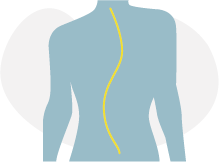In most cases, adolescent scoliosis is treated with conservative measures. However, this depends specifically on the degree of curvature of the patient’s spine.
In mild scoliosis, when the curvature is less than 20 degrees, the most common practice is to monitor the progression of the curve with regular checkups, and perform postural exercises to keep the muscles as toned as possible so that the curvature does not continue to progress. This kind of regular monitoring will allow us to act quickly if, for example, the patient’s curve were to worsen by 15 to 20 degrees between two visits and we see that there is a risk of the scoliosis becoming more severe.
In patients with curves between 20 to 40 degrees, the postural exercises can be combined with wearing a brace. This can be worn at night, or 24 hours a day, to help straighten the spine.
Surgical treatment to correct the scoliosis is only recommended in cases with a spinal curve greater than 40 or 45 degrees, where there is significant deformity affecting the patient's quality of life.




